
|
Japanese External Reverse Porro Prism Binoculars. WEBSITE MUSEUM |
|
OTHER BINOCULARS #7 & OPTICAL SIGHTS (MOSTLY MILITARY) |
|
US Army Signal Corps 7x50 binoculars of Task Force 43/ Operation Deep Freeze member Antarctic Explorer Amory H. Bud Waite (11 Arctic Expeditions, and won congressional medal) |
|
My U.S. Army Signal Corps “ Task Force 43 ” “ Operation Deep Freeze ”, and “ Waite ” marked binoculars are another example of where an object itself is far less interesting than it’s associations to remarkable events. These military binoculars previously were issued to Amory H. Bud Waite, who was radio operator on eleven Antarctic expeditions and on many other polar expeditions. While Waite was on Admiral Byrd’s 1933 second Antarctic expedition in July/Aug. 1934, and stationed at the Little America Antarctic base, Waite was credited with all 3 attempts to rescue Admiral Byrd from a remote base (hut), including the successful rescue involving a 123 mi trek by Citroen tractor for 70 straight hours by 3 men in -70 ° F average temperatures ( -56.7 ° C) to reach the barely alive Byrd at the Boiling Weather Station hut on the Ross Ice shelf, where the 4 men subsequently spent 10 weeks in the 9 foot by 13 foot hut, while Byrd recovered from long term carbon monoxide poisoning. Waite received a congressional medal for it. These binoculars probably date to Waite’s involvement in 1946-47 Antarctic Operation Highjump where he was a US Army Signal Corps observer, or to his 1954-1955 time aboard the icebreaker U.S.S. Antka circumnavigating the Antarctic, and these are marked for his eight 1956-65 Operation Deep Freeze expeditions, and his time with Task Force 43, which were the nine ships of the 1955-65 Deep Freeze Expeditions. These binoculars have no visible manufacturer markings, but appear to be the Bausch and Lomb 7x50 binocular design in m24 case that the US govenment bought in large quantity from many companies in many variations, with the hard life these had and an old repaint having obscuring markings. |
|
1990’s Chinese PLA/ Peoples Liberation Army Type 62-8WYJ 8x30 Military Binoculars Factory #298/ Yunnan Yuanjin Optical Co. |
|
My Type 62 8x30 Peoples Liberation Army/ Chinese military pattern binoculars were made at factory #298, which later became Yunnan Yuanjin Optical Co. These Type 62 binoculars were PLA issue from the 1960’s-1990s, but were also made for and were supplied to the military forces of other countries, such as North Vietnam/Vietnam. These binoculars were claimed to be 1990’s production NOS, and with engraved rather than silk screen markings they may well be 1990’s, production, but the basic design is still in production. These binoculars have odd pellet filled desiccant compartments. |

|
Bud Waite |

|
Task Force 43 ship USS Wyandot, during operation Deep Freeze |





|
1941 Anchor Optical Corp. 7x50 U.S. Navy Binoculars Mk 1 Mod 2 |
|
Ca 1919-1921 Carl Zeiss Jena Silvamar Binoculars Donated to the US Navy in 1942 for WWII use, with Documented pre and post war Owners, and Returned to Owner at War’s end |


|
Around 1942, as the US became more involved in the Battle of the Atlantic, and as German U boats became more active near US shores, the U.S. govt. launched a public campaign for civilians to “lend” Zeiss and Bausch and Lomb binoculars to the US Navy with a promise of returning them later. U.S. wars (as largely foreign territory wars) tend to be a struggle of interests between those in favor and opposed, with influencing public opinion a key factor in the political power to proceed. So the campaign to donate binoculars (with WPA/ Works Project Administration assistance) was functionally as much a marketing means to manipulate and control public opinion, as it was an actual materials acquisition effort. Of course many of the donated binoculars were probably not useful. It appears that those actually suitable to be issued were marked with an acquisition year, an acquisition number, and the name of the owner “loaning them”. Owners were paid $1 loan compensation, which was part of a liability waiver. These circa 1919-1921 Carl Zeiss Jena Silvamar binoculars serial number 964,608 were donated by Samuel Margolies and taken into US Navy use in 1942 and were marked “ BU SHIPS”; “U.S. NAVY”; “TREATED M.I. N.Y”; (probably Materials Inspection); “No. 2714”; 1942” and “SAMUEL MARGOLIES” at than time. BuShips was the US Navy Bureau of Ships, which was created in June 1940, and managed procurement. |
|
Anchor Optical Corp of NY was one of 6 companies to whom leading US optical company Bausch and Lomb licensed their designs as part of the U.S. WWII war effort, and who they also assisted to gear and staff up and produce US military binoculars in WWII (per Company Seven). My 1941 Anchor Optical Co US Navy 7x50 Mk1 Model 2 serial # 8030 binoculars are quite typical of these. BuShips was the US Navy Bureau of Ships, which was created in June 1940, and which managed US Navy procurement. |
|
After the war, these binoculars were returned to Samuel Margolies, and then were passed on to his son Roy S. Margolies of Mountainside NJ (himself a WWII navy vet who served as engineer on LST 741 during Landings in Leyte Gulf, Lingayen Gulf, and Mindoro Gulf), and who then died at age 90 in 2013. The New Jersey state drivers license number scratched on these binoculars is presumably that of Roy S. Margolis, as that practice was promoted as a theft deterrent measure around the 1960’s for cameras and binoculars. Again, binoculars with an interesting history. |








|
1936 Ross No.6 Mk1 4x25 British Military Binoculars |





|
My 1936 Ross No.6 Mk.1 4x25 British military binoculars serial no.1972 are broad arrow military property marked. Supposedly 5,000 were ordered in 1936 for anti-aircraft searchlight units (so no reticule/ ranging grid) with some probability of the smaller size of this militarized Steplux model being for female AA battery personnel. Among deficiencies, they tend to fall over when placed upright on a flat surface. They were quickly declared obsolete in Dec. 1936. |
|
Two 1916 German Busch Stellux US Army Signal Corps and U.S.Army Type D 8x Binoculars |



|
ABOVE BUSCH STELLUX BINOCULARS KINDLY DONATED TO THE COLLECTION BY Binocular collector JACK INNIS. |


|
My excerpts from the US Army Signal Corps Manual #3 of 1916 show that my pocket size CF German Busch Stellux 8x binoculars serial # “D”4489 were issued to U.S. Army Signal Corps Field companies as Type D binoculars , and with “ SIGNAL CORPS U.S. ARMY ” stamping, and D prefix serial number were probably part of a contract batch ordered to be issued to members of a US Army signal corps field company, for observing signals. |







|
(ca 1896 ?) Carl Zeiss Jena D.R.P. 8x20 D.F. 95 Military Binoculars with graticule serial # 6973 |
|
Carl Zeiss Jena introduced the distinctive pattern of “bent or sloped shoulder“ DF95 8x20 military binoculars in 1895, and I think mine were made in 1896, with the oculars updated by a 1898 German military contract retrofit. My example has a left ocular military strichplatte/ ranging grid or reticule. The D.R.P. marking is Deutsches Reichs Patent. The binoculars would originally have had bakelite ocular cups. |




|
DF95 and “No. 6973” are hard to see |
|
These would have been advanced prism based optics around the beginning of the shift from Galilean to prismatic binoculars. |
|
Carl Zeiss Danish HTK/H æ rens Tekniske Korps 6 x 30 b Military binoculars |




|
My Carl Zeiss West German made 6x30 B binoculars carry the Danish military property crown, and the HTK marking of the H æ rens Tekniske Korps (Army Technical Corps), which from 1909 to 1968 was the Danish military material command. These high quality binoculars predate 1968, (probably made around 1962), and are part of recent military surplus releases. They have a right ocular ranging reticule. Thanks go to Marija at military dealer UAB Militar , in Klap ē dos, Lithuania, for picking me a very a nice example to purchase and to be able to document here. |


|
1917 Carl Zeiss WWI German Issued Australian Captured & Reissued No.3 Mk 0 6x24 binoculars |


|
My WWI Australian military binoculars are German 1917 dated Carl Zeiss German Military issued ( Dienstglas marked) DF 6x24 military binoculars that were captured and taken into Australian military service, as indicated by D ↑ D Australian property markings, and re-stamped as Australian No.3 Mk 0 military pattern binoculars, which are the model binoculars produced in 1917 by the Zeiss London firm seized and taken over by Ross in 1917 for UK/ Commonwealth military contracts. (None of the normal Zeiss London binoculars had German military Dienstglas markings, and they were marked “Zeiss London”: see our example in Other Binoculars #8), while these are marked Carl Zeiss Jena . These were over-painted green. Both binoculars and tin case are marked T.P.1 , the standard Australian military abbreviation for Troop 1. I view these as having substitute standard equivalent markings. |





|
Australian D ↑ D military property mark |
|
U.S. Navy Carl Zeiss Silvarem 6x30 binoculars donated during WWII in 1942 |
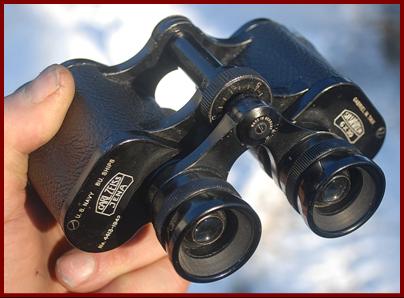


|
This is another one of my civilian owned Carl Zeiss 6x30 Silvarem binoculars that had been donated to the US WWII war effort and had also been taken into service by the U.S. Navy Bureau of ships in 1942, in this case assigned to be property no 4413. They were intended to be returned to the owner, Gabriel M. Taix, and they are marked as such with his name, as was the practice on many such donated binoculars. Gabriel M. Taix was probably French born Gabriel Marius Taix of California, who died in 1993, but this is speculative. |

|
WWI Talbot Reel and Manufacturing Co. US Army Signal Corps Binoculars |

|
My WWI US Army Signal Corps binoculars are another example of U.S. industrial flexibility and role assignment during wartimes. Talbot Reel and manufacturing Co. made fishing reels and were located in Kansas City Missouri USA from 1913-1920, and obviously were assigned to make contract binoculars during WWI for the US army. |





|
See also US Army Signal Corps binoculars made by the US Navy Optical Shop Annex in OTHER BINOCULARS #6 |
|
1918 A. Kershaw & Son Ltd WWI British No. 3 Mk1 6x military binoculars |




|
My 1918 WWI Kershaw & Son No. 1 Mk 1 British army binoculars have the facing broad arrow British military property marks indicating release from service. They are marked to A.W. Fuller Acland-Hood, who I believe to be Sir Alexander William-Acland-Hood, (later became 6th Baronet Hood), born in 1901. He went to the Royal Military Academy, and was a lieutenant in the Royal Engineers, and moved to California the USA after WWI. (speculative) |

|
WWI ca 1917 1918 Bausch & Lomb US Army Signal Corps 6x30 military binoculars |

|
WWII 1942/ 43 German Army 6x30/ DYM Runge und Kaulfu ß Fabrik f ü r Optik Dienstglas binoculars |
|
My WWII dym manufacturer coded 6x30 German military binoculars were made by Runge and Kaufus in Rathenow in 1942 or in 1943, and have a H6400 strichplatte or right side graticule/ ranging grid. The “O” marking indicated the use of 1416 cold weather grease introduced on November 1 1942 (credit Hans Seeger). The manufacturer German name is Runge und Kaulfu ß Fabrik f ü r Feinmechanik und Optik, which also was known under the brand logo of RUKA. These follow the standardized approved pattern of German WWII 6x30 Dienstglas military binoculars. |
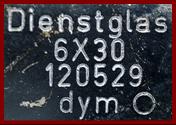




|
The origins of Bausch & Lomb date to 1853 when they sold imported European eyewear and manufactured monocles. The firm began producing binoculars in 1890. From 1892 and in close cooperation with Carl Zeiss Optische Werkat ä tte, Bausch & Lomb began producing lenses, and by 1907 Zeiss owned 20 percent of the company, and the two firms had many licensing agreements. The origin of the triangle logo was a corporate alliance between Bausch & Lomb, Zeiss, and Saegmuller and was related to pre WWI US military contracts. When the US entered WWI on Apr.6, 1917, 2,000 lbs of military optical glass a day was projected needed, and by Mar. 1918 Bausch & Lomb was producing 35,000 lbs a month as the U.S. primary lens manufacturer, as well as being a major producer of all completed US WWI military optical devices. |

|
My binoculars came in a U.S. Naval Gun Factory marked case with mounted compass made by Crown Optical Co. (The US Navy seized the Crown Optical Co in Rochester on Dec. 1917). |


|
Ca 1902 Carl Zeiss Jena D.R.P. Feldstecher Vegr. = 8. Civilian Binoculars serial number #19982 |
|
Carl Zeiss Jena produced my model of civilian prismatic Vegr.=8. (8 power) Feldstecher (Field Glasses) with markings in elegant script from 1894-1904. The D.R.P. marking is Deutsches Reichs Patent.
|
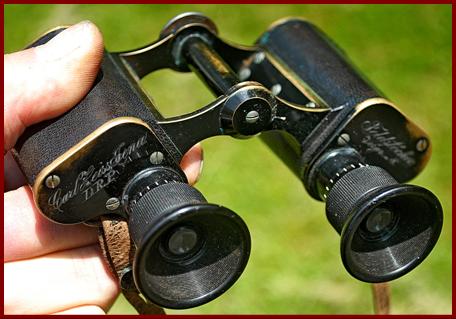
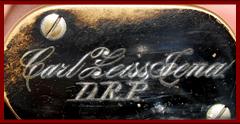
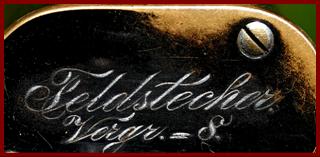


|
Based on script marking date range, eyepiece design date range, and similar “Binocollection.com” example, I think my binoculars date to 1902. |
|
NON MINIATURE BINOCULARS & OPTICS: MOSTLY MILITARY |
|
1917 Carl Zeiss Jena D.F. 10x50 German Army Dienstglas WWI Military Binoculars |

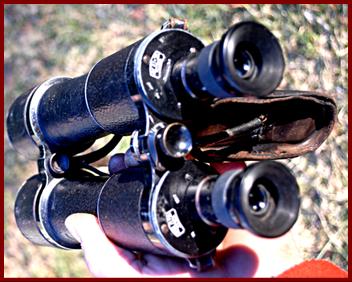
|
My 1917 WWI dated German 10x50 military binoculars are Dienstglas German Military property marked, which has been defaced or scratched out. It is quite common when a soldier liberates government binoculars that they will deface or obscure or cover up the government ownership property mark and this is likely the case on these. These are a good high end example of the twin telescope origin of binoculars. The “ K ” marking is believed to be an acceptance mark of GPK Spandau. The “ D.F . ” marking is for Doppelfernrohr (Double telescope). The ocular cover is typical of military use. |

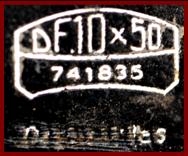

|
These type binoculars were also available to Army officers for private purchase as personal gear in 1916/1917 through the U.S. Army Signal Corps .(The US declared war on Germany in April 1917, so once supplies on hand were disbursed additional supply shipments of German Busch Stellux & Terux binoculars to the US Army would have been unavailable. I believe my second pair of Busch Stellux 8x binoculars serial # 89512 binoculars were part of the private purchase contracted supply. The Busch and Stellux logos are engravings and more decorative, the serial number does not have a D prefix, and the US Army marking is engraved and suggests them going to an army officer but not necessarily to an Army Signal Corps officer, and the officer is named B.E. Grey. |
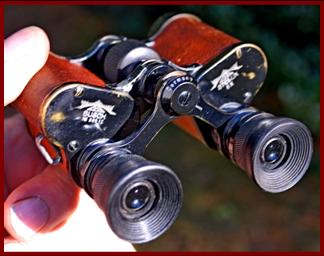

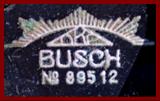

![Text Box: CLICK ON PAGE LINE. CLIQUEZ SUR LA LIGNE DE PAGE. KLICKEN SIE AUF SEITENZEILE. HAGA CLIC EN LÍNEA DE PÁGINA..[ページ行]をクリックします。НАЖМИТЕ НА СТРОКУ СТРАНИЦЫ. ALSO SEE INDEX.](image918.gif)
|
Carl Zeiss Jena D.R.P. DF 6x. Military Binoculars serial number #5775 |




|
Carl Zeiss Jena produced my model DF6x binoculars with italic markings around 1902 to around 1907 The D.R.P. marking is Deutsches Reichs Patent. According to binocollection.com (who has the same model with higher serial number 9671 and binocular P.No5751), this was a military model binocular, and the . “ P. No .” is “Privatnummer” for private purchase exclusively by German military officers as a numbered piece part of a German military purchase contract. I believe my example was probably made in 1902 or 1903 |
